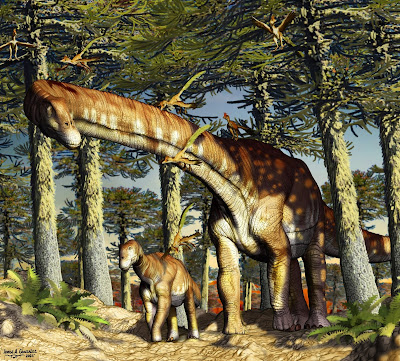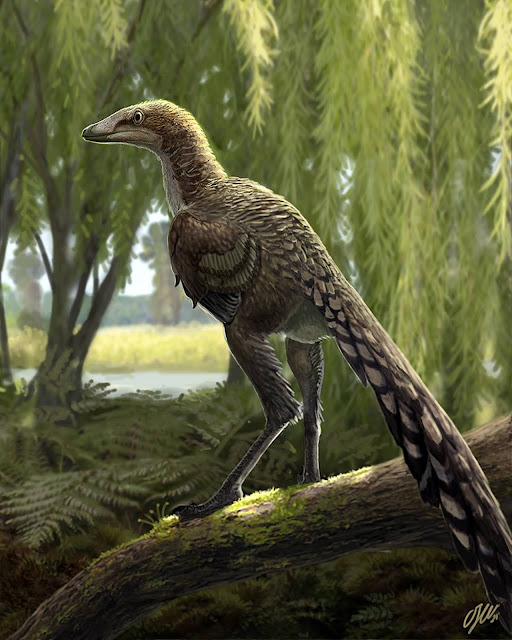[Most Recent Entries] [Calendar View]
Tuesday, March 2nd, 2021
| Time | Event | ||
| 10:19a | [Paleontology • 2021] Ninjatitan zapatai • The Earliest Known Titanosaur Sauropod Dinosaur
Abstract The titanosaur sauropod record of Patagonia, mainly recovered from Upper Cretaceous strata, is probably the richest worldwide. Here we present a new sauropod dinosaur, Ninjatitan zapatai gen. et sp. nov., from the Lower Cretaceous Bajada Colorada Formation (Berriasian–Valanginian) of north Patagonia (Neuquén Province, Argentina), from which postcranial remains are preserved. The anatomical analysis and comparisons performed in this specimen evidence strong affinity with titanosaur sauropods. This assumption is corroborated with the inclusion of the new taxon in an updated phylogenetic data matrix. The cladistic analyses indicate that Ninjatitan could be considered the earliest known titanosaur sauropod. The combination of features such as the presence of procoelous anterior caudal centra, the pneumatized neural arch of anterior caudal vertebrae, and the posterodorsal border of the scapular acromion near the glenoid level supports its titanosaur affinities. The presence of a basal titanosaurian sauropod in the lowermost Cretaceous of Patagonia supports the hypothesis that the group was established in the Southern Hemisphere and reinforces the idea of a Gondwanan origin for Titanosauria. The Bajada Colorada sauropod fauna represents one of the most diverse and unique associations from the lowermost Cretaceous worldwide recorded. Keywords: Sauropoda, Titanosauria, Lower Cretaceous, Patagonia Pablo Ariel Gallina, Juan Ignacio Canale and José Luis Carballido. 2021. The Earliest Known Titanosaur Sauropod Dinosaur. Ameghiniana. 58(1); 35–51. DOI: 10.5710/AMGH.20.08.2020.3376 The earliest titanosaur in the world was discovered in Patagonia Paleontologists present in society Ninjatitan zapatai, a new titanosaur from Patagonia that passes into the hall of fame among these colossi that walked on Earth for being the oldest of its group. This animal, about 20 meters in length, lived 140 million years ago, which demonstrates that these gigantic dinosaurs were originated at the beginning of the Cretaceous period. | ||
| 10:53a | [Paleontology • 2021] Tamarro insperatus • A Fast-growing Basal Troodontid (Theropoda: Maniraptora) from the latest Cretaceous of Europe
Abstract A characteristic fauna of dinosaurs and other vertebrates inhabited the end-Cretaceous European archipelago, some of which were dwarves or had other unusual features likely related to their insular habitats. Little is known, however, about the contemporary theropod dinosaurs, as they are represented mostly by teeth or other fragmentary fossils. A new isolated theropod metatarsal II, from the latest Maastrichtian of Spain (within 200,000 years of the mass extinction) may represent a jinfengopterygine troodontid, the first reported from Europe. Comparisons with other theropods and phylogenetic analyses reveal an autapomorphic foramen that distinguishes it from all other troodontids, supporting its identification as a new genus and species, Tamarro insperatus. Bone histology shows that it was an actively growing subadult when it died but may have had a growth pattern in which it grew rapidly in early ontogeny and attained a subadult size quickly. We hypothesize that it could have migrated from Asia to reach the Ibero-Armorican island no later than Cenomanian or during the Maastrichtian dispersal events. Systematic palaeontology Dinosauria Owen, 1842 Theropoda Marsh, 1881 Coelurosauria Huene, 1914 Maniraptora Gauthier, 1986 Troodontidae Gilmore 1924 ? Jinfengopteryginae Turner, Makovicky, and Norell, 2012 Tamarro insperatus gen. et sp. nov. Etymology: Tamarro, Catalan word referring to a small and elusive fantastic creature from the regional (Pallars county) folklore. Insperatus, from the Latin word for “unexpected”, in reference to the unexpected discovery of the specimen. Holotype: MCD-7073, a partial right metatarsal II. Diagnosis: Tamarro insperatus is a mid-sized basal troodontid distinguished by the following unique combination of characters (* marks potential autapomorphies): metatarsal II with marked plantar ridge; small foramen on the lateral surface of the plantar ridge of the metatarsal II*; sub-arctometatarsalian condition with the metatarsal III restricted to the plantar margin on its proximal part. Type locality and age: Sant Romà d’Abella locality (Pallars Jussà, Catalonia); upper part of the Talarn Formation of the Tremp Group. The site is correlated with the C29r magnetochron14, latest Maastrichtian age. Conclusions: The discovery of the new basal troodontid Tamarro insperatus at the very end of the Cretaceous in Europe represents the first evidence of bones of Troodontidae in Europe. Both phylogenetic and osteohistological results support the basal nature of the new taxon, most likely as a representative of the Asian clade Jinfengopteryginae. The histological analysis also has provided evidence for a mature individual with a high growth rate, which allowed the animal to attain subadult body size in a very short time. This growth strategy is similar to other basal troodontids, such as the Asian Mei long. The fragmentary, yet controversial, record of troodontid-like teeth from Europe together with the likely Asian affinity of Tamarro, confirm that troodontids could have reached the ancient European Archipelago during the Late Cretaceous. Furthermore, the relatively large size of Tamarro insperatus compared with its closest phylogenetic relatives suggests it would be the largest among jinfengopterygines. Albert G. Sellés, Bernat Vila, Stephen L. Brusatte, Philip J. Currie and Àngel Galobart. 2021. A Fast-growing Basal Troodontid (Dinosauria: Theropoda) from the latest Cretaceous of Europe. Scientific Reports. 11: 4855. DOI: 10.1038/s41598-021-83745-5 |
| << Previous Day |
2021/03/02 [Calendar] |
Next Day >> |









